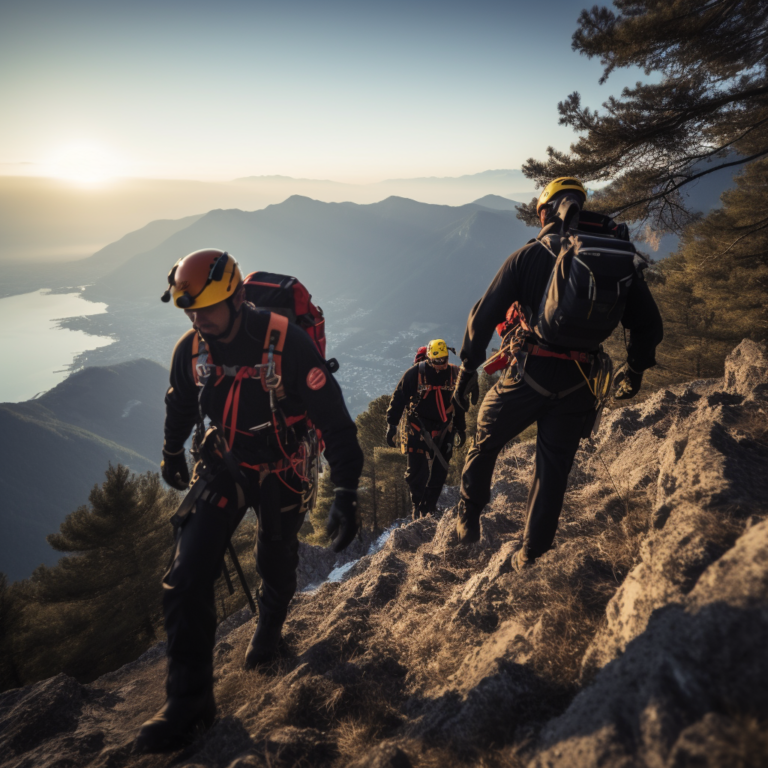For those who work in search and rescue (SAR) or fire service, physical fitness is crucial. Lives depend on how well team members can perform their jobs under the rigors of harsh outdoor environments, heights, and steep terrains. Traditional cardiovascular exercise regimes such as running on the treadmill or jogging around the block might not be enough. Therefore, SAR and fire service professionals have developed nontraditional workout regimes that impart high levels of cardio endurance needed for their specific needs. This blog explores SAR team ground and search, SAR team with high angle and steep terrain, fire service with mostly urban rope rescue calls, and fire service with lots of steep and high angle calls whether rural or urban. By the end, you’ll understand why nontraditional workouts for cardiovascular endurance might be precisely what you need to improve your fitness levels.
1.SAR Ground Team Workout Regimen
Ground search operations require that the team members have considerable physical fitness levels because they walk, run, crawl, and carry heavy equipment for long periods. To develop their cardio endurance, SAR teams combine running exercises, weightlifting, and obstacle course training. For instance, running with a weighted backpack and using resistance bands to mimic dragging heavy equipment is common. Team members also practice obstacle courses that include sprints and dodging obstacles, which improves their agility and endurance. SAR teams might also adopt a mix of yoga, Tai-Chi, or other forms of meditation that keep their minds and bodies balanced.
Cardiovascular Endurance Training (Ground Team Specific):
- Running Drills:
- Exercise: Interval running with varied intensity.
- Purpose: Simulates the unpredictable nature of ground search operations.
- Weighted Backpack Running:
- Exercise: Running with a weighted backpack.
- Purpose: Builds endurance while simulating the weight of equipment carried during missions.
- Trail Running:
- Exercise: Running on uneven terrain.
- Purpose: Enhances agility and adaptability to different ground surfaces.
2.SAR High-Angle and Steep Terrain Team Workout Regimen
SAR teams that work in high-angle terrains like cliffs, mountains, or ravines are exposed to greater risks, mainly if rescue missions extend into the night. Cardio endurance is essential for such teams to be alert and to carry equipment through such demanding terrains. These teams engage in cross-training that involves a mix of cardio and weightlifting workouts. Exercises might involve alternating between weighted rope pulls, tire flip, and rope climbing. Furthermore, sets of cardio exercises such as burpees, jumping jacks, and squat jumps, interspersed with handgrips, are also recommended.
Cardiovascular Endurance Training (High/Steep Angle Team Specific):
- Hill Sprints:
- Exercise: Sprinting uphill.
- Purpose: Builds cardiovascular endurance while simulating steep terrain conditions.
- Stair Climbing:
- Exercise: Climbing stairs or using a stair climber.
- Purpose: Strengthens lower body muscles used for ascending steep slopes.
- Backpack Ascents:
- Exercise: Ascending steep terrain with a weighted backpack.
- Purpose: Mimics the added load during high-angle operations.
3. Urban and Rural Fire Service Workout Regimen
Urban rope rescue calls often involve high-rise buildings, and fire service teams may be required to climb up or repel down multiple floors to rescue victims. Cardio endurance is critical for team members, especially when there is a need to move fast. Such teams engage in workouts such as rope climbing, weighted suitcase carries, tire flips, and push-and-pull sleds. Fire service teams might also include nontraditional workouts such as Brazilian Jiu-Jitsu or Parkour, which helps to develop agility and cardio endurance.
Cardiovascular Fitness for Urban Challenges:
- HIIT Workouts:
- Exercise: High-Intensity Interval Training (HIIT) involving sprints, burpees, and jumping jacks.
- Purpose: Mimics the sudden bursts of intense activity often required in urban firefighting.
- Stair Running:
- Exercise: Running up and down stairs or using a stair climber.
- Purpose: Builds cardiovascular endurance for navigating multi-story structures.
- Interval Running in Urban Settings:
- Exercise: Running drills incorporating changes in pace, direction, and terrain.
- Purpose: Simulates the dynamic nature of urban firefighting.
4.Steep and High-Angle Fire Service Workout Regimen:
For fire service teams that get a mix of rural or urban calls that involve steep or high-angle terrains, unique cardio workouts are necessary. The crews engage in workouts such as weighted stair climbs, squat and overhead press, and battle ropes. Such workouts help to increase cardio endurance by building the core and leg strength of the crew members. Fire service teams may also incorporate climbing walls, hiking with heavy backpacks, and bodyweight exercises such as push-ups, sit-ups, squats, and lunges to increase their stamina.
Cardiovascular and Stair Climbing:
- High-Intensity Stair Climbing:
- Exercise: Rapid ascent and descent of stairs.
- Purpose: Builds cardiovascular endurance and simulates high-angle scenarios involving multi-story structures.
- Interval Running on Inclines:
- Exercise: Running drills on uphill terrain.
- Purpose: Enhances stamina and endurance for navigating steep landscapes.
- Stair Tower Simulation:
- Exercise: Climbing stairs with added weight and equipment.
- Purpose: Replicates the physical demands of carrying gear up structures during high-angle operations.
Summary:
In conclusion, nontraditional workout regimes provide SAR and fire service professionals with the essential cardio endurance needed for their jobs. These unique exercises are adaptable to the terrain, the equipment, and the nature of the emergency. By adopting these nontraditional cardio workouts, SAR and fire service professionals can improve their stamina, agility, and strength, which could ultimately increase their life-saving capabilities. So, if you work in SAR or fire services, consider exploring nontraditional cardio workout regimes specific to your needs, and take your fitness levels to the next level today.









